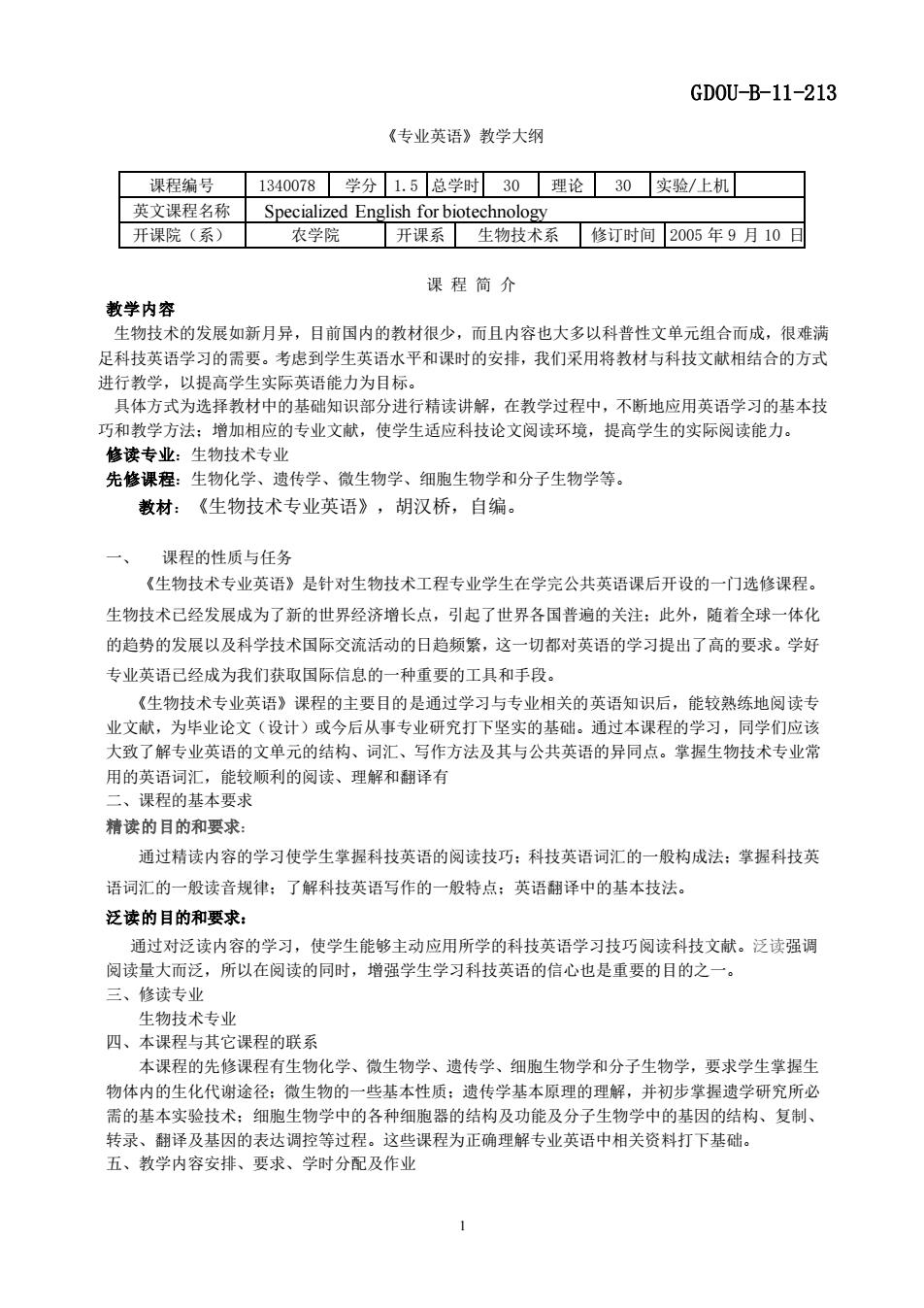
GD0U-B-11-213 《专业英语》教学大纲 课程编号1340078学分1.5总学时30理论30实验/上机 英文课程名称Specialized English for biotechnology 开课院(系) 农学院开课系生物技术系修订时间2005年9月10可 课程简介 教学内容 生物技术的发展如新月异,目前国内的教材很少,而且内容也大多以科普性文单元组合而成,很难满 足科技英语学习的需要。考虑到学生英语水平和课时的安排,我们采用将教材与科技文献相结合的方式 进行教学 以提高学生实际英语能力为目标 具体方式为选 教材中 础知识部分进行精读讲解,在教学过程中,不断地应用英语学习的基本技 巧和教学方法:增加相应的专业文献,使学生适应科技论文阅读环境,提高学生的实际阅读能力。 修读专业:生物技术专业 先修课程:生物化学、遗传学、微生物学、细胞生物学和分子生物学等。 教材:《生物技术专业英语》,胡汉桥,自编 果程的性质与任务 《生物技术专业英语》是针对生物技术工程专业学生在学完公共英语课后开设的一门选修课程。 生物技术已经发展成为了新的世界经济增长点,引起了世界各国普遍的关注:此外,随着全球一体化 的趋势的发展以及科学技术国际交流活动的日趋频繁,这一切都对英语的学习提出了高的要求。学好 专业英语己经成为我们获取国际信息的一种重要的工具和手段。 《生物技术专业英语》课程的主要目的是通过学习与专业相关的英语知识后,能较熟练地阅读专 业文献,为毕业论文(设计)或今后从事专业研究打下 坚实的基础。通过本课程的学习,同学们应 大致了解专业英语的文单元的结构、词汇、写作方法及其与公共英语的异同点。掌握生物技术专业常 用的英语词汇,能较顺利的阅读、理解和翻译有 二、课程的基本要求 精读的目的和要求: 通过精读内容的学习使学生掌握科技英语的阅读技巧:科技英语词汇的一般构成法:掌握科技英 语词汇的一般读音规律:了解科技英语写作的一般特点:英语翻译中的基本技法。 泛读的目的和要求: 通过对泛读内容的学习,使学生能够主动应用所学的科技英语学习技巧阅读科技文献。泛读强调 阅读量大而泛,所以在阅读的同时,增强学生学习科技英语的信心也是重要的目的之 三、修读专 生物技术专业 四、本课程与其它课程的联系 本课程的先修课程有生物化学、微生物学、遗传学、细胞生物学和分子生物学,要求学生掌握生 物体内的生化代谢途径:微生物的一些基本性质:遗传学基本原理的理解,并初步掌据遗学研究所必 需的基本实验技术:细胞生物学中的各种细胞器的结构及功能及分 生物 中的基因的结构、复制 转录、翻译及基因的表达调控等过程。这些课程为正确理解专业英语中相关资料打下基础。 五、教学内容安排、要求、学时分配及作业
1 《专业英语》教学大纲 课程编号 1340078 学分 1.5 总学时 30 理论 30 实验/上机 英文课程名称 Specialized English for biotechnology 开课院(系) 农学院 开课系 生物技术系 修订时间 2005 年 9 月 10 日 课 程 简 介 教学内容 生物技术的发展如新月异,目前国内的教材很少,而且内容也大多以科普性文单元组合而成,很难满 足科技英语学习的需要。考虑到学生英语水平和课时的安排,我们采用将教材与科技文献相结合的方式 进行教学,以提高学生实际英语能力为目标。 具体方式为选择教材中的基础知识部分进行精读讲解,在教学过程中,不断地应用英语学习的基本技 巧和教学方法;增加相应的专业文献,使学生适应科技论文阅读环境,提高学生的实际阅读能力。 修读专业:生物技术专业 先修课程:生物化学、遗传学、微生物学、细胞生物学和分子生物学等。 教材:《生物技术专业英语》,胡汉桥,自编。 一、 课程的性质与任务 《生物技术专业英语》是针对生物技术工程专业学生在学完公共英语课后开设的一门选修课程。 生物技术已经发展成为了新的世界经济增长点,引起了世界各国普遍的关注;此外,随着全球一体化 的趋势的发展以及科学技术国际交流活动的日趋频繁,这一切都对英语的学习提出了高的要求。学好 专业英语已经成为我们获取国际信息的一种重要的工具和手段。 《生物技术专业英语》课程的主要目的是通过学习与专业相关的英语知识后,能较熟练地阅读专 业文献,为毕业论文(设计)或今后从事专业研究打下坚实的基础。通过本课程的学习,同学们应该 大致了解专业英语的文单元的结构、词汇、写作方法及其与公共英语的异同点。掌握生物技术专业常 用的英语词汇,能较顺利的阅读、理解和翻译有 二、课程的基本要求 精读的目的和要求: 通过精读内容的学习使学生掌握科技英语的阅读技巧;科技英语词汇的一般构成法;掌握科技英 语词汇的一般读音规律;了解科技英语写作的一般特点;英语翻译中的基本技法。 泛读的目的和要求: 通过对泛读内容的学习,使学生能够主动应用所学的科技英语学习技巧阅读科技文献。泛读强调 阅读量大而泛,所以在阅读的同时,增强学生学习科技英语的信心也是重要的目的之一。 三、修读专业 生物技术专业 四、本课程与其它课程的联系 本课程的先修课程有生物化学、微生物学、遗传学、细胞生物学和分子生物学,要求学生掌握生 物体内的生化代谢途径;微生物的一些基本性质;遗传学基本原理的理解,并初步掌握遗学研究所必 需的基本实验技术;细胞生物学中的各种细胞器的结构及功能及分子生物学中的基因的结构、复制、 转录、翻译及基因的表达调控等过程。这些课程为正确理解专业英语中相关资料打下基础。 五、教学内容安排、要求、学时分配及作业 GDOU-B-11-213
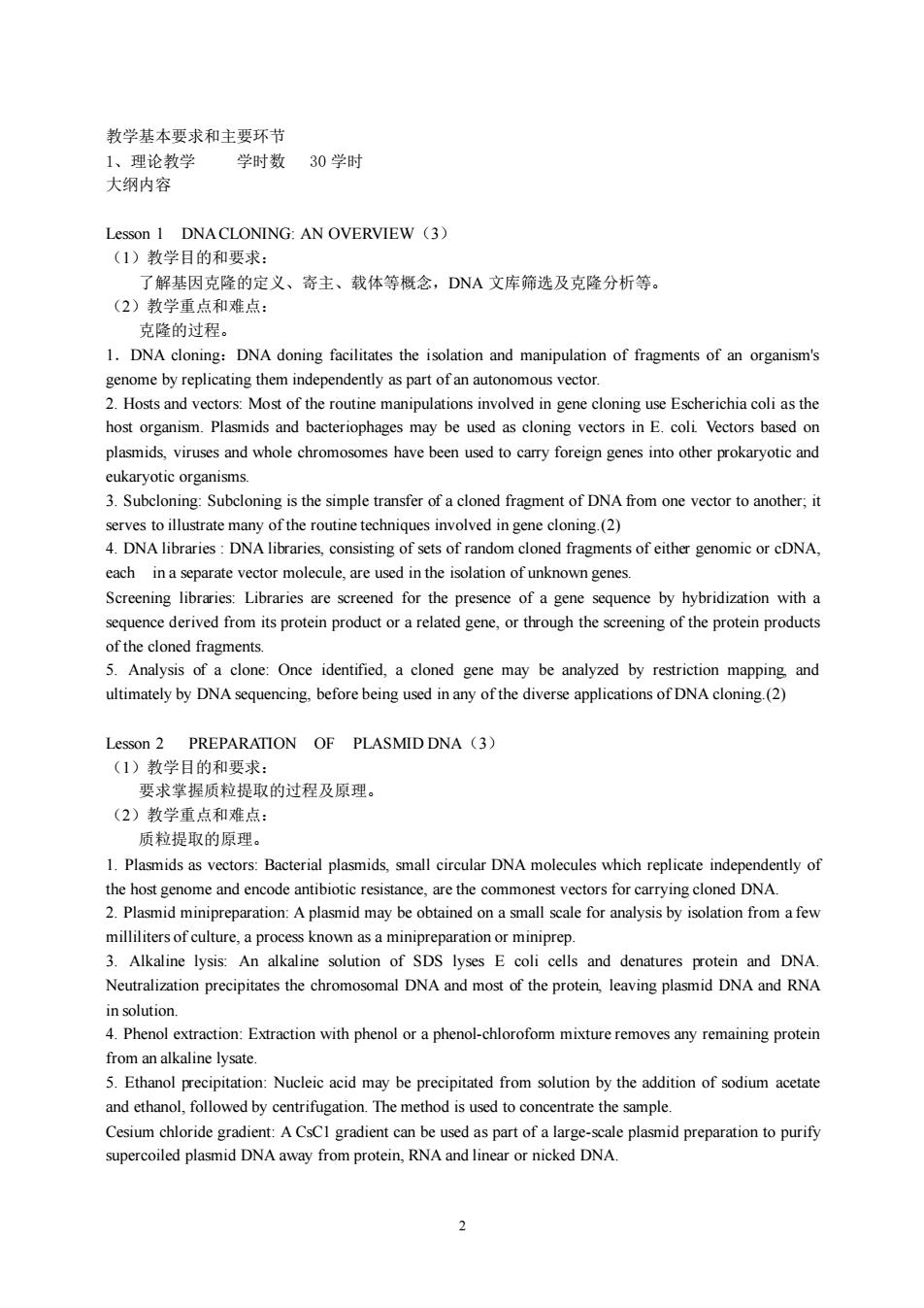
教学基本要求和主要环节 1、理论教学 学时数30学时 大纲内容 Lesson I DNACLONING:AN OVERVIEW (3) (1)教学目的和要求: 了解基因克隆的定义、寄主、载体等概念,DNA文库筛选及克隆分析等 (2) 克隆的过程。 1.DNA cloning:DNA doning facilitates the isolation and manipulation of fragments of an organism's genome by replicating them independently as part of an autonomous vector. host organism.Plasmids and bacteriophage may be used as clonin vectors in E.coli Vectors based on plasmids,viruses and whole chromosomes have been used to carry foreign genes into other prokaryotic and eukaryotic organisms. 3.Subcloning:Subcloning is the simple transfer of a cloned fragment of DNA from one vector to another;it serves to illustrate many of the routine technigues involved in gene cloning (2) 4.DNA:.consisting of sets of random coned fragments of the nomic or cDNA. each in a separate vector molecule,are us in the isolation of unknown genes Screening libraries:Libraries are screened for the presence of a gene sequence by hybridization with a sequence derived from its protein product or a related gene,or through the screening of the protein products of the cloned fragments 5.Analysis of a clone:Once identified,a cloned gene may be analyzed by restriction mapping and uimately by before being usd nany ofthe divers applications of( Lesson 2 PREPARATION OF PLASMID DNA(3) (1)教学目的和要求: 要求掌握质粒提取的过程及原理。 (2)教学重占和难占 质粒提取的原理。 1.Plasmids as vectors:Bacterial plasmids,small circular DNA molecules which replicate independently of the host genome and encode antibiotic resistance,are the commonest vectors for carrying cloned DNA. 2.Plasmid minipreparation:A plasmid may be obtained on a small scale for analysis by isolation from a few milliliters of culture,a process known as a minip reparation r miniprep. 3 Alkaline lysis: alkalin solution of SDS lyses Ecoli cells and denatures protein and DNA Neutralization precipitates the chromosomal DNA and most of the protein,leaving plasmid DNA and RNA in solution. 4.Phenol extraction:Extraction with phenol or a phenol-chlorofom mixture removes any remaining protein from an alkaline lysate. and ethano,followed by centrifugation.The method is used toconcentrate the sample Cesium chloride gradient:A CsCI gradient can be used as part of a large-scale plasmid preparation to purify supercoiled plasmid DNA away from protein,RNA and linear or nicked DNA
2 教学基本要求和主要环节 1、理论教学 学时数 30 学时 大纲内容 Lesson 1 DNA CLONING: AN OVERVIEW(3) (1)教学目的和要求: 了解基因克隆的定义、寄主、载体等概念,DNA 文库筛选及克隆分析等。 (2)教学重点和难点: 克隆的过程。 1.DNA cloning:DNA doning facilitates the isolation and manipulation of fragments of an organism's genome by replicating them independently as part of an autonomous vector. 2. Hosts and vectors: Most of the routine manipulations involved in gene cloning use Escherichia coli as the host organism. Plasmids and bacteriophages may be used as cloning vectors in E. coli. Vectors based on plasmids, viruses and whole chromosomes have been used to carry foreign genes into other prokaryotic and eukaryotic organisms. 3. Subcloning: Subcloning is the simple transfer of a cloned fragment of DNA from one vector to another; it serves to illustrate many of the routine techniques involved in gene cloning.(2) 4. DNA libraries : DNA libraries, consisting of sets of random cloned fragments of either genomic or cDNA, each in a separate vector molecule, are used in the isolation of unknown genes. Screening libraries: Libraries are screened for the presence of a gene sequence by hybridization with a sequence derived from its protein product or a related gene, or through the screening of the protein products of the cloned fragments. 5. Analysis of a clone: Once identified, a cloned gene may be analyzed by restriction mapping, and ultimately by DNA sequencing, before being used in any of the diverse applications of DNA cloning.(2) Lesson 2 PREPARATION OF PLASMID DNA(3) (1)教学目的和要求: 要求掌握质粒提取的过程及原理。 (2)教学重点和难点: 质粒提取的原理。 1. Plasmids as vectors: Bacterial plasmids, small circular DNA molecules which replicate independently of the host genome and encode antibiotic resistance, are the commonest vectors for carrying cloned DNA. 2. Plasmid minipreparation: A plasmid may be obtained on a small scale for analysis by isolation from a few milliliters of culture, a process known as a minipreparation or miniprep. 3. Alkaline lysis: An alkaline solution of SDS lyses E coli cells and denatures protein and DNA. Neutralization precipitates the chromosomal DNA and most of the protein, leaving plasmid DNA and RNA in solution. 4. Phenol extraction: Extraction with phenol or a phenol-chloroform mixture removes any remaining protein from an alkaline lysate. 5. Ethanol precipitation: Nucleic acid may be precipitated from solution by the addition of sodium acetate and ethanol, followed by centrifugation. The method is used to concentrate the sample. Cesium chloride gradient: A CsC1 gradient can be used as part of a large-scale plasmid preparation to purify supercoiled plasmid DNA away from protein, RNA and linear or nicked DNA
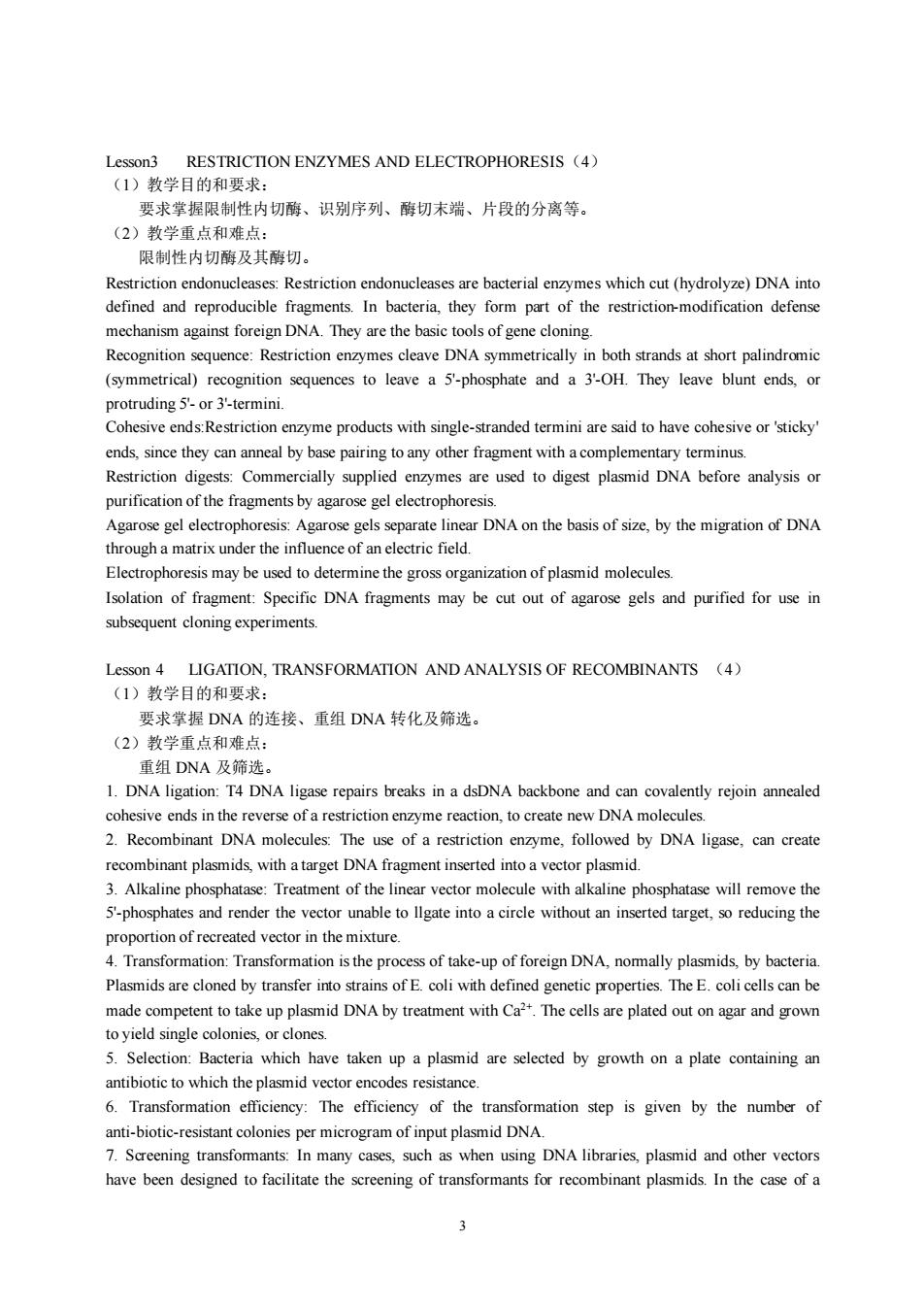
Lesson3 RESTRICTION ENZYMES AND ELECTROPHORESIS (4) (1)教学目的和要求 要求掌握限制性内切酶、识别序列、酶切末端、片段的分离等。 (2)教学重点和难点: 限制性内切移及其酶切 mechanism against foreign DNA.They are the basic tools of gene cloning. Recognition sequence:Restriction enzymes cleave DNA symmetrically in both strands at short palindromic (svmmetrical)recognition sequences to leave a 5-phosphate and a 3-0H.They leave blunt ends.or truding 5'-or 3'-termini. enzyme products with single-stranded termini are said to have cohesive or'sticky ends,since they can anneal by base pairing to any other fragment with a complementary terminus. Restriction digests:Commercially supplied enzymes are used to digest plasmid DNA before analysis or purification of the fragments by agarose gel electrophoresis. oh a matrix ectric field. Electrophoresis may be used to determine the gross organization ofplasmid molecules Isolation of fragment:Specific DNA fragments may be cut out of agarose gels and purified for use in subsequent cloning experiments Lesson 4 LIGATION,TRANSFORMATION AND ANALYSIS OF RECOMBINANTS (4) (1)教学目的和要求 要求掌握DNA的连接、重组DNA转化及筛选。 (2)教学重点和难点: 重组DNA及筛选。 1.DNA ligation:T4 DNA ligase repairs breaks in a dsDNA backbone and can covalently rejoin annealed ohesive ends in the revers of 2.Recombinant DNA molecules The use of a restriction enzyme,followed by DNA ligase.can create recombinant plasmids.with a target DNA fragment inserted into a vector plasmid. 3.Alkaline phosphatase:Treatment of the linear vector molecule with alkaline phosphatase will remove the 5'-phosphates and render the vector unable to llgate into a circle without an inserted target,so reducing the nof in the mixture Plasmids are cloned by transfer into strains ofE coli with defined genetic properties.The E.colicells can be made competent to take up plasmid DNA by treatment with Ca2.The cells are plated out on agar and grown to vield single colonies.or clones. 5.Selection:Bacteria which have taken up a plasmid are selected by growth on a plate containing antibiotic to which the plasmid ve ctor er 6.Transformation efficiency:The efficiency of the transformation step is given by the number of anti-biotic-resistant colonies per microgram of input plasmid DNA. 7.Screening transformants:In many cases,such as when using DNA libraries,plasmid and other vectors have been designed to facilitate the screening of transformants for recombinant plasmids.In the case of a 3
3 Lesson3 RESTRICTION ENZYMES AND ELECTROPHORESIS(4) (1)教学目的和要求: 要求掌握限制性内切酶、识别序列、酶切末端、片段的分离等。 (2)教学重点和难点: 限制性内切酶及其酶切。 Restriction endonucleases: Restriction endonucleases are bacterial enzymes which cut (hydrolyze) DNA into defined and reproducible fragments. In bacteria, they form part of the restriction-modification defense mechanism against foreign DNA. They are the basic tools of gene cloning. Recognition sequence: Restriction enzymes cleave DNA symmetrically in both strands at short palindromic (symmetrical) recognition sequences to leave a 5'-phosphate and a 3'-OH. They leave blunt ends, or protruding 5'- or 3'-termini. Cohesive ends:Restriction enzyme products with single-stranded termini are said to have cohesive or 'sticky' ends, since they can anneal by base pairing to any other fragment with a complementary terminus. Restriction digests: Commercially supplied enzymes are used to digest plasmid DNA before analysis or purification of the fragments by agarose gel electrophoresis. Agarose gel electrophoresis: Agarose gels separate linear DNA on the basis of size, by the migration of DNA through a matrix under the influence of an electric field. Electrophoresis may be used to determine the gross organization of plasmid molecules. Isolation of fragment: Specific DNA fragments may be cut out of agarose gels and purified for use in subsequent cloning experiments. Lesson 4 LIGATION, TRANSFORMATION AND ANALYSIS OF RECOMBINANTS (4) (1)教学目的和要求: 要求掌握 DNA 的连接、重组 DNA 转化及筛选。 (2)教学重点和难点: 重组 DNA 及筛选。 1. DNA ligation: T4 DNA ligase repairs breaks in a dsDNA backbone and can covalently rejoin annealed cohesive ends in the reverse of a restriction enzyme reaction, to create new DNA molecules. 2. Recombinant DNA molecules: The use of a restriction enzyme, followed by DNA ligase, can create recombinant plasmids, with a target DNA fragment inserted into a vector plasmid. 3. Alkaline phosphatase: Treatment of the linear vector molecule with alkaline phosphatase will remove the 5'-phosphates and render the vector unable to llgate into a circle without an inserted target, so reducing the proportion of recreated vector in the mixture. 4. Transformation: Transformation is the process of take-up of foreign DNA, normally plasmids, by bacteria. Plasmids are cloned by transfer into strains of E. coli with defined genetic properties. The E. coli cells can be made competent to take up plasmid DNA by treatment with Ca2+ . The cells are plated out on agar and grown to yield single colonies, or clones. 5. Selection: Bacteria which have taken up a plasmid are selected by growth on a plate containing an antibiotic to which the plasmid vector encodes resistance. 6. Transformation efficiency: The efficiency of the transformation step is given by the number of anti-biotic-resistant colonies per microgram of input plasmid DNA. 7. Screening transformants: In many cases, such as when using DNA libraries, plasmid and other vectors have been designed to facilitate the screening of transformants for recombinant plasmids. In the case of a
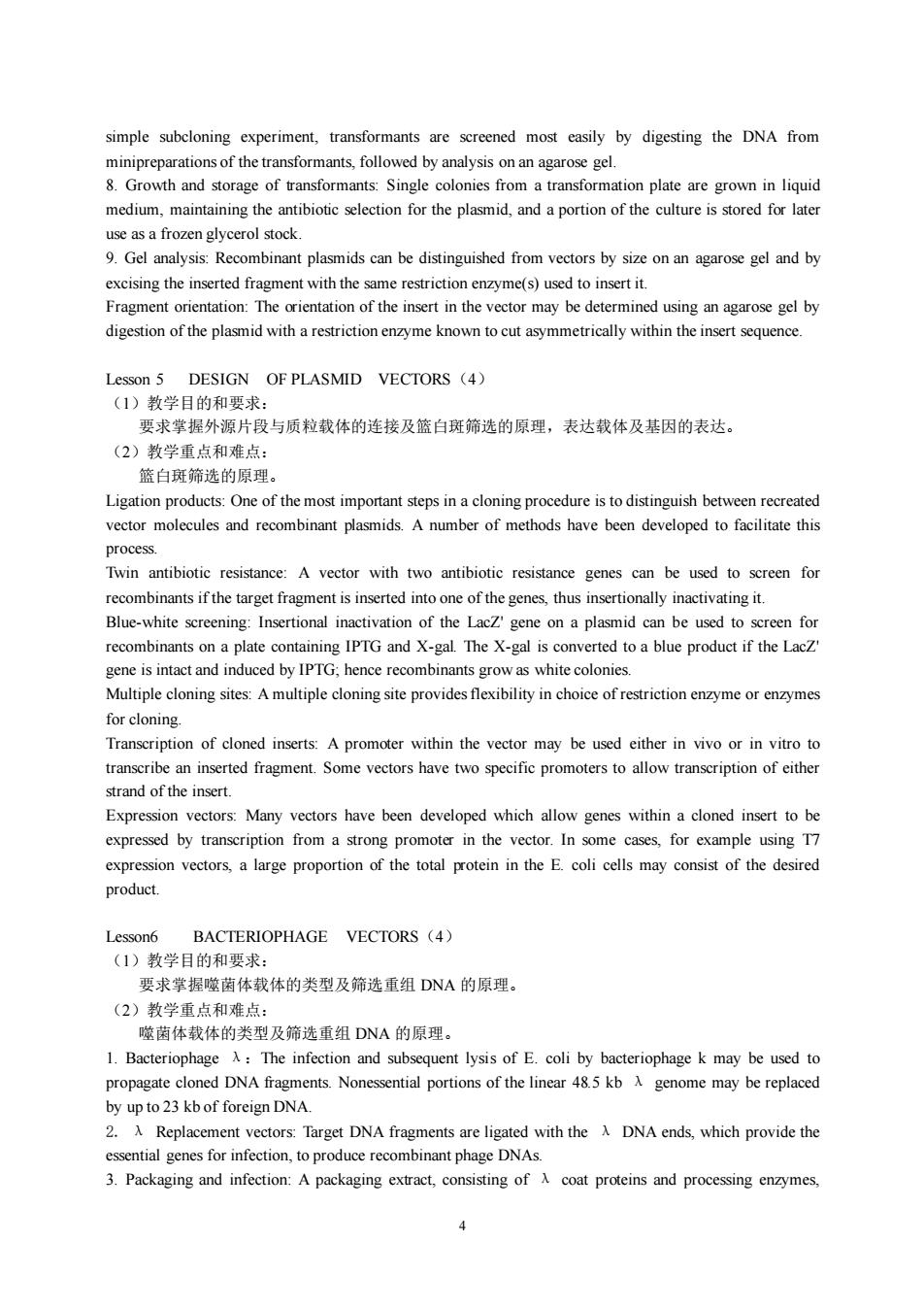
simple subcloning experiment.transformants are screened most easily by digesting the DNA from mnprpaaionsohernsf6mansfol6adbynasonngroe时 Growth and storage of ransformants Single froma transformation plate are grown in liqui medium,maintaining the antibiotic selection for the plasmid,and a portion of the culture is stored for later use as a frozen glycerol stock. 9.Gel analysis:Recombinant plasmids can be distinguished from vectors by size on an agarose gel and by ned using an agarose gel by digestion of the plasmid with a restriction enzyme known to cut asymmetrically within the insert sequence. Lesson 5 DESIGN OF PLASMID VECTORS (4) (1)教学目的和要求: 题求掌握外题片段与质拉载体的连接及篮白斑篇洗的原理,表达载体及基因的表达。 (2) 教学重点和难点 篮白斑筛选的原理 Ligation products:One of the most important steps in a cloning procedure is to distinguish between recreated vector molecules and recombinant plasmids.A number of methods have been developed to facilitate this resistance:A vector with two antibiotic resistance genes can be used to screen fo recombinants if the target fragment is inserted into one of the genes,thus insertionally inactivating it. Blue-white screening:Insertional inactivation of the LacZ'gene on a plasmid can be used to screen for recombinants on a plate containing IPTG and X-gal The X-gal is converted to a blue product if the Lacz gene is intact and induced by IPTG;hence recombinants grow as white colonies. for cloning. Transcription of cloned inserts:A promoter within the vector may be used either in vivo or in vitro to transeribe an inserted fragment.Some vectors have two specific promoters to allow transeription of either strand ofthe insert Expression vectors:Many vectors have been developed which allow genes within insert to be expressed by transcription from a strong promoter in the vector.In some cases.for example using T expression vectors,a large proportion of the total protein in the E.coli cells may consist of the desired product. Lesson6 BACtERIOPHAGE VECTORS (4) (1)教学目的和要求: 要求掌握噬菌体载体的类型及筛选重组DNA的原理, (2)教学重点和难点: 噬菌体载体的类型及筛选重组DNA的原理。 1.Bacteriophage:The infection and subsquent lysis of E.coi by bacteriophage k may be used to propaga loned DNA fra nts.Non ssential portions of the linear 48 kb genome may be replaced by up to 23 kbof foreign DNA 2.A Replacement vectors:Target DNA fragments are ligated with the A DNA ends,which provide the essential genes for infection,to produce recombinant phage DNAs. 3.Packaging and infection:A packaging extract.consisting of A coat proteins and processing enzymes
4 simple subcloning experiment, transformants are screened most easily by digesting the DNA from minipreparations of the transformants, followed by analysis on an agarose gel. 8. Growth and storage of transformants: Single colonies from a transformation plate are grown in liquid medium, maintaining the antibiotic selection for the plasmid, and a portion of the culture is stored for later use as a frozen glycerol stock. 9. Gel analysis: Recombinant plasmids can be distinguished from vectors by size on an agarose gel and by excising the inserted fragment with the same restriction enzyme(s) used to insert it. Fragment orientation: The orientation of the insert in the vector may be determined using an agarose gel by digestion of the plasmid with a restriction enzyme known to cut asymmetrically within the insert sequence. Lesson 5 DESIGN OF PLASMID VECTORS(4) (1)教学目的和要求: 要求掌握外源片段与质粒载体的连接及篮白斑筛选的原理,表达载体及基因的表达。 (2)教学重点和难点: 篮白斑筛选的原理。 Ligation products: One of the most important steps in a cloning procedure is to distinguish between recreated vector molecules and recombinant plasmids. A number of methods have been developed to facilitate this process. Twin antibiotic resistance: A vector with two antibiotic resistance genes can be used to screen for recombinants if the target fragment is inserted into one of the genes, thus insertionally inactivating it. Blue-white screening: Insertional inactivation of the LacZ' gene on a plasmid can be used to screen for recombinants on a plate containing IPTG and X-gal. The X-gal is converted to a blue product if the LacZ' gene is intact and induced by IPTG; hence recombinants grow as white colonies. Multiple cloning sites: A multiple cloning site provides flexibility in choice of restriction enzyme or enzymes for cloning. Transcription of cloned inserts: A promoter within the vector may be used either in vivo or in vitro to transcribe an inserted fragment. Some vectors have two specific promoters to allow transcription of either strand of the insert. Expression vectors: Many vectors have been developed which allow genes within a cloned insert to be expressed by transcription from a strong promoter in the vector. In some cases, for example using T7 expression vectors, a large proportion of the total protein in the E. coli cells may consist of the desired product. Lesson6 BACTERIOPHAGE VECTORS(4) (1)教学目的和要求: 要求掌握噬菌体载体的类型及筛选重组 DNA 的原理。 (2)教学重点和难点: 噬菌体载体的类型及筛选重组 DNA 的原理。 1. Bacteriophage λ:The infection and subsequent lysis of E. coli by bacteriophage k may be used to propagate cloned DNA fragments. Nonessential portions of the linear 48.5 kb λ genome may be replaced by up to 23 kb of foreign DNA. 2. λ Replacement vectors: Target DNA fragments are ligated with the λ DNA ends, which provide the essential genes for infection, to produce recombinant phage DNAs. 3. Packaging and infection: A packaging extract, consisting of λ coat proteins and processing enzymes
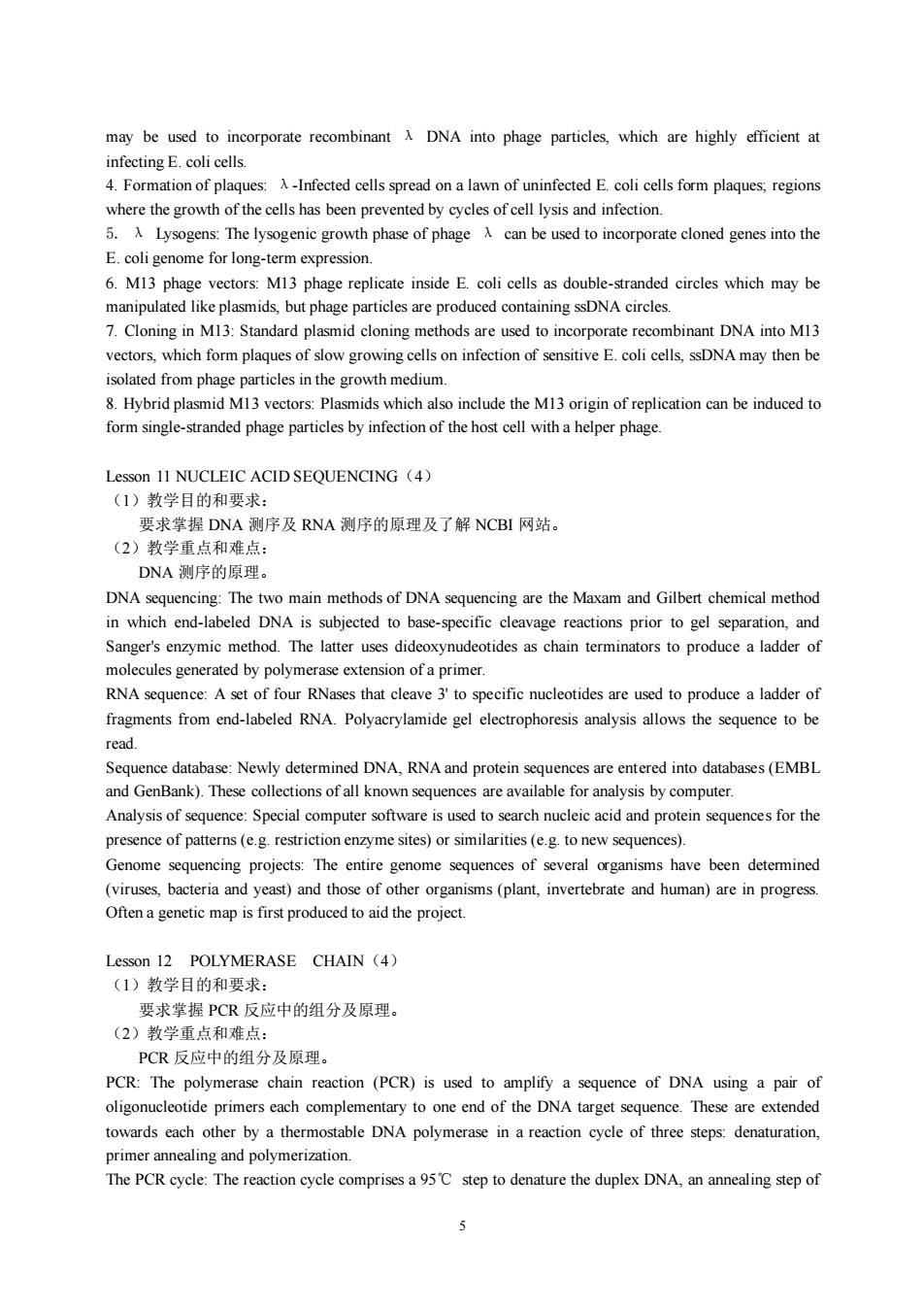
may be used to incorporate recombinant DNA into phage particles.which are highly efficient at -Infected cells spread onalawn of uninfected E.coli cells form plaques,regions where the growth of the cells has been prevented by cycles of cell lysis and infection. 5.Lysogens:The lysogenic growth phase of phage can be used to incorporate cloned genes into the E.coli genome for long-term expression. 6.M13 vectors M phage replicate inside E.as doubleranded which may be smids,but phage particles are produced containing ssDNA circles 7.Cloning in M13:Standard plasmid cloning methods are used to incorporate recombinant DNA into M13 vectors,which form plaques of slow growing cells on infection of sensitive E.coli cells,ssDNA may then be isolated from phage particles in the growth medium. 8.Hybrid plasmid M13 vectors:Plas ids which also include the M13 or gin of replicationcan be induced to form single-tranded phage particles by infectio of the host cell withahelper phage Lesson 11 NUCLEIC ACID SEOUENCING (4) (1)教学目的和要求: 要求掌握DNA测序及RNA测序的原理及了解NCBI网站。 (2)教学面占和难占 DNA测序的原理 DNA sequencing:The two main methods of DNA sequencing are the Maxam and Gilbert chemical method in which end-labeled DNA is subjected to base-specifie cleavage reactions prior to gel separation,and Sanger's enzymic method.The latter uses dideoxynudeotides as chain terminators to produce a ladder of molecules g erated by polymerase extension of a primer. RNA of four RNases that cleaveto specife nucleotides re used to produce a ladder of fragments from end-labeled RNA.Polyacrylamide gel electrophoresis analysis allows the sequence to be read. Sequence database:Newly determined DNA.RNA and protein sequences are entered into databases(EMBL and GenBank).These collections of all known sequences are available for analysis by computer. tein sequences for the presence of patterns(e.g.restriction enzyme sites)or similarities(e.g.to new sequences). Genome sequencing projects:The entire genome sequences of several organisms have been determined (viruses.bacteria and yeast)and those of other organisms(plant,invertebrate and human)are in progress Ofena genetic map is first produced to aid the project 12 POLYMERASE CHAIN (4) (1)教学目的和要求: 要求掌握PCR反应中的组分及原理。 (2)教学重点和难点: PCR反应中的组分及原理】 of oligonucleotide primers each complementary to one end of the DNA target sequence.These are extended towards each other by a thermostable DNA polymerase in a reaction cycle of three steps:denaturation, primer annealing and polymerization. The PCR cycle:The reaction cycle step to denature the duplex DNA,an annealing step of
5 may be used to incorporate recombinant λ DNA into phage particles, which are highly efficient at infecting E. coli cells. 4. Formation of plaques: λ-Infected cells spread on a lawn of uninfected E. coli cells form plaques; regions where the growth of the cells has been prevented by cycles of cell lysis and infection. 5. λ Lysogens: The lysogenic growth phase of phage λ can be used to incorporate cloned genes into the E. coli genome for long-term expression. 6. M13 phage vectors: M13 phage replicate inside E. coli cells as double-stranded circles which may be manipulated like plasmids, but phage particles are produced containing ssDNA circles. 7. Cloning in M13: Standard plasmid cloning methods are used to incorporate recombinant DNA into M13 vectors, which form plaques of slow growing cells on infection of sensitive E. coli cells, ssDNA may then be isolated from phage particles in the growth medium. 8. Hybrid plasmid M13 vectors: Plasmids which also include the M13 origin of replication can be induced to form single-stranded phage particles by infection of the host cell with a helper phage. Lesson 11 NUCLEIC ACID SEQUENCING(4) (1)教学目的和要求: 要求掌握 DNA 测序及 RNA 测序的原理及了解 NCBI 网站。 (2)教学重点和难点: DNA 测序的原理。 DNA sequencing: The two main methods of DNA sequencing are the Maxam and Gilbert chemical method in which end-labeled DNA is subjected to base-specific cleavage reactions prior to gel separation, and Sanger's enzymic method. The latter uses dideoxynudeotides as chain terminators to produce a ladder of molecules generated by polymerase extension of a primer. RNA sequence: A set of four RNases that cleave 3' to specific nucleotides are used to produce a ladder of fragments from end-labeled RNA. Polyacrylamide gel electrophoresis analysis allows the sequence to be read. Sequence database: Newly determined DNA, RNA and protein sequences are entered into databases (EMBL and GenBank). These collections of all known sequences are available for analysis by computer. Analysis of sequence: Special computer software is used to search nucleic acid and protein sequences for the presence of patterns (e.g. restriction enzyme sites) or similarities (e.g. to new sequences). Genome sequencing projects: The entire genome sequences of several organisms have been determined (viruses, bacteria and yeast) and those of other organisms (plant, invertebrate and human) are in progress. Often a genetic map is first produced to aid the project. Lesson 12 POLYMERASE CHAIN(4) (1)教学目的和要求: 要求掌握 PCR 反应中的组分及原理。 (2)教学重点和难点: PCR 反应中的组分及原理。 PCR: The polymerase chain reaction (PCR) is used to amplify a sequence of DNA using a pair of oligonucleotide primers each complementary to one end of the DNA target sequence. These are extended towards each other by a thermostable DNA polymerase in a reaction cycle of three steps: denaturation, primer annealing and polymerization. The PCR cycle: The reaction cycle comprises a 95℃ step to denature the duplex DNA, an annealing step of

around 55C to allow the primers to bind and a 72C polymerization step.Mgand dNTPs are required in Template Almost any source that contains one or more intact target DNA molecule can,in theory.be amplified by PCR.providing appropriate primers can be designed. Primers:A pair of oligonucleotides of about 18-30 nt with similar G+C content will serve as PCR primers long as they direct DNA synthesis towards one another.Primers with some degeneracy can also be used if he target DNAquence isnot completely known. Taq polymerase)are used in PCR as they survive the hot denaturation step.Some are more error-prone than others. PCR optimization:It may be necessary to vary the annealing temperature and/or the Mgconcentration to obtain faithful amplification.From complex mixtures,a second pair of nested primers can improve specificity. 考核方式:平时成绩(0%),期末考试(100%,闭卷) :验内容与要求 序号T 实验内容 学时 4 5 六、教材与参考书 本课程选用教材: (生物技术专业英语》,胡汉桥,自编 本课程推荐参考书: KInstant Notes in Molecular Biology ISBN 7-03-007305-3/Q.847 BIOS Science Publisher,UK 1997, 科学出版社2002年(影印版) 执笔:胡汉桥 审核: 批准人: 时间: 6
6 around 55℃ to allow the primers to bind and a 72℃ polymerization step. Mg2+ and dNTPs are required in addition to template, primers, buffer and enzyme. Template: Almost any source that contains one or more intact target DNA molecule can, in theory, be amplified by PCR, providing appropriate primers can be designed. Primers: A pair of oligonucleotides of about 18--30 nt with similar G+C content will serve as PCR primers as long as they direct DNA synthesis towards one another. Primers with some degeneracy can also be used if the target DNA sequence is not completely known. Enzymes: Therostable DNA polymerase(e.g. Taq polymerase) are used in PCR as they survive the hot denaturation step. Some are more error-prone than others. PCR optimization: It may be necessary to vary the annealing temperature and/or the Mg2+ concentration to obtain faithful amplification. From complex mixtures, a second pair of nested primers can improve specificity. 考核方式:平时成绩(0%),期末考试(100%,闭卷) 实验内容与要求 序号 实验内容 学时 1 2 3 4 5 六、教材与参考书 本课程选用教材: 《生物技术专业英语》,胡汉桥,自编。 本课程推荐参考书: 《Instant Notes in Molecular Biology》 ISBN 7-03-007305-3/Q.847 BIOS Science Publisher ,UK 1997, 科学出版社 2002 年(影印版) 执笔:胡汉桥 审核: 批准人: 时间: